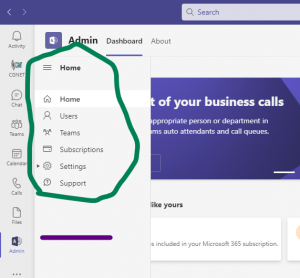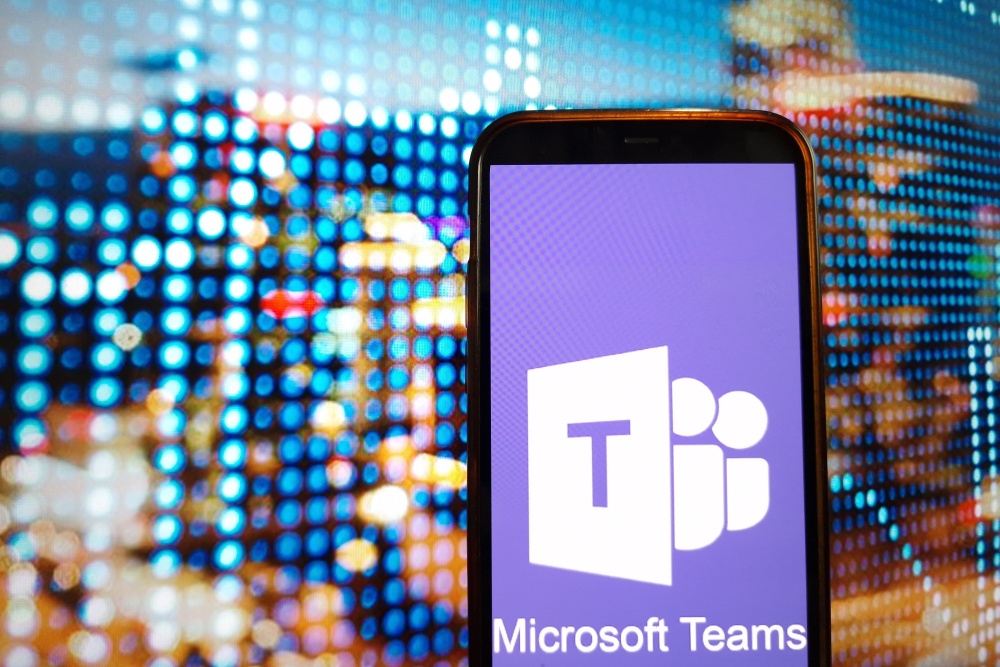My hot take? The word “casual” comes to mind.
What Does the Teams Admin App Do?
Think of the “80/20 Rule” applied to Teams administration. The Teams admin app puts administration right within Teams and focuses on the use cases that are most common. More specifically, you can manage
- Users
- Teams
- Subscriptions
There is also a Settings menu, where you can manage settings related to
- Meetings
- Messages
- Files
- Webinars
For instance, you can view and remove users, change your Microsoft 365 subscriptions, and see a complete list of Teams that have been created. You may not see the same choices as I have, depending on what Microsoft 365 administrative role you have.
With the Settings tab you can manage the more commonly used settings for messages, meetings, and the like. For instance, you can turn meeting transcription on or off.
As I mentioned above, the Teams admin app surfaces the most used admin choices. You can
- Set whether and under what circumstances you want to automatically admit people to a meeting
- Allow or disallow dial-in users to bypass the meeting lobby
- Allow or disallow cloud recording
- Allow or disallow meeting transcription
- Allow or disallow a participant to request control or give control to another user
- What you cannot do within the Teams admin app is set up URLs that you include with each meeting invitation, for things like your Support site or privacy policy. You also cannot set Quality of Service controls.
Beyond these limitations, the Teams Admin center also manages “Live Event” (aka “webinar?”) settings and policies, as well as meeting policies and conference bridge settings.
What Do I Think?
The Teams admin app correctly figures that it can collect the most-used admin functions and place them more centrally in the Teams experience. Is it a big deal that you can’t change the Support URL from the Teams admin app? How often does it change anyway?
Now that I have said something nice, let me move on to the not-so-nice comments.
As the article I referenced above notes, there are no controls over who can download the Teams admin app from the Microsoft app store. If you are a Teams user and do not have administrative privileges, the app won’t do anything. I know that some people will come back with “hey, why is the user downloading the app anyway?” True, but an app that does not work for non-app reasons is not a good user experience. This was my first clue that maybe this is the “minimum viable product” version of the Teams admin app.
My next clue was that you have to click on the Home button to even see the administration options. I would have preferred to have the major admin functions set up as tabs across the top of the app.

I also have issues with having access to users and Microsoft 365 subscriptions. If I had just a Teams Admin role, I would not see these options. Nevertheless, I find it a little scary that someone (like me!) could mess up our Active Directory by adding and removing users. Likewise, I would not want the average person to be able to change or modify our Microsoft 365 subscriptions.
Security Cannot be a Bolt-On
My biggest issue with the Teams admin app concerns—you guessed it—security. The comments following the article note that the Teams admin app works if you, the user, are also the administrator. This violates the principle (which we recommend) of separating user accounts and admin accounts. This seems like a big miss. Dan-the-User is the person who belongs to various Teams. But Dan-the-Administrator should be the one managing Teams.
If you are a small organization without dedicated IT management, the Teams admin app may do enough of the right things to be worthwhile. Unfortunately, the apparently casual approach to security is a fatal flaw.
How Will We Solve for Cross-Platform App Management?
I can sense the conversations among the Teams product team. Sure, it would be nice to put the Teams admin app functions across the Team tabs. But that complicates the design, because we must go back and solve for a different, conflicting use case in the tabs UI.
This points out a dilemma Microsoft and others face. They built “platform” products like SharePoint and Dynamics. And with that, they built the administrative interface to manage all the options and settings attendant with those platforms. Now, a generation of cross-platform apps emerges. These apps want to hide the underlying platform capabilities to make the apps more approachable.
But below the glossy exterior, you still have these platforms. Teams is a perfect example. Teams is built on top of SharePoint (groups), Active Directory (users and groups), Exchange (email) and OneDrive (storage). And OneDrive is itself built on top of SharePoint. No wonder the administration is spread out.
We can hope that future cross-platform administration either
- Guides us through the component platform admin screens. We are trying to manage a Team, and there is a layer that shows us the component platform admin screens but moves us from one screen to the next so we can accomplish the task.
- Creates a shell program that accomplishes the component admin steps for us. We say what we want to do, the shell program collects some information, and then it navigates the component platform admin screens to get the job done.
I would not recommend the Teams admin app until it addresses the security topic above. Even then, I would rather face the complexity of Teams administration than have an easy-to-use tool with limited functionality.





0 Comments